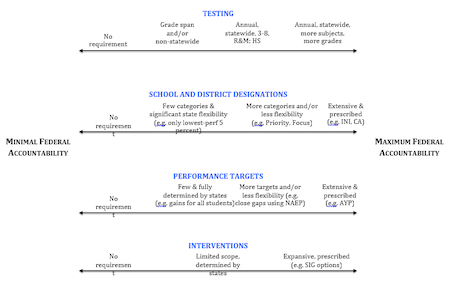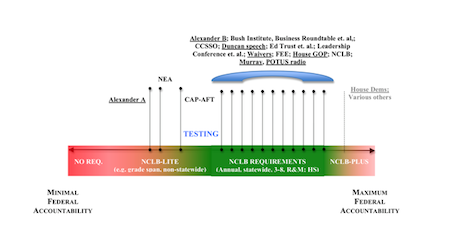A couple weeks ago, I created a graphic to help explain the contours of the debate about federal accountability in the ESEA reauthorization process. My immediate purpose was to show that the blanket term “accountability” actually includes four dimensions, each of which includes a range of possible policies. I organized each of the four along a continuum, with “minimum” and “maximum” federal accountability representing the two ends.

The ultimate purpose of the graphic was to serve as a tool for assessing various proposals and, hopefully, revealing where a final compromise might be found.
Since then, I’ve read all the major proposals, speeches, press releases, and news accounts I could find. In this post, I focus only on what I’ve learned about testing.
I’ve plotted on the continuum the highest-profile proposals. Bear in mind that this is not an exact science. Apart from the congressional bills, the proposals are somewhat vague, and trying to turn words into images involves some artistic license. These caveats notwithstanding, three major lessons were revealed.

1. Emerging Consensus
In the middle-right, you’ll see a group of proposals with a blue bracket. All of these either explicitly embrace the NCLB suite of tests or strongly imply that this is their preference. The left/right orientation of the bracketed proposals doesn’t convey additional meaning; all of these proposals are virtually the same on this dimension. I’ve listed them above the bracket in alphabetical order.
The obvious takeaway is that there is agreement on testing among a wide array of major players, including:
• The bill passed by the House education committee
• One of the two options offered by Senator Alexander
• Senator Murray’s ESEA floor speech
• The president’s radio address and Secretary Duncan’s speech
• CCSSO
• The George W. Bush Institute
• The diverse groups organized by Ed Trust, the Business Roundtable, and the Leadership Conference on Civil and Human Rights
• The Foundation for Excellence in Education
• The official policies of both NCLB and the Obama administration’s ESEA-waiver initiative
I’ve underlined the proposals of this debate’s principals: Republican and Democratic leaders in Congress and the Obama administration. You can see they’ve largely coalesced around NCLB’s approach to federal testing.
2. Loneliness on the Left
For a while, it seemed that if ESEA were to be reauthorized, it would be with fewer assessments.
• The NEA’s proposal called for “reducing the number of federally-mandated (sic) tests and restoring ‘grade-span’ testing—once in elementary, once in middle, and once in high school.” Hence its placement considerably to the left of NCLB’s requirements.
• CAP teamed with AFT to offer a “compromise”: NCLB’s annual tests would stay for informational purposes, but only one test per grade span would be linked to accountability (hence its placement between the grade-span and NCLB approaches)
• Even Senator Alexander’s draft offered a far-reduced assessments option. As Politics K-12 described it, states could use grade-span tests or portfolios, combine formative assessment results, experiment with competency-based systems, rely on district-created tests, or conjure up something else.
Sen. Alexander’s minimal-testing proposal all but invited others to follow suit—his proposal could’ve served as political cover for those opposed to federally mandated tests. What’s completely fascinating and absolutely noteworthy is that he essentially offered to host a party on the far left of the spectrum, and apart from the unions, no one RSVP’d.
Below the spectrum, I created a political-consensus heat map. It appears that an NCLB-like system is now firmly in an area of consensus (color-coded green). As we move away from it (to either side), the green shifts to red (decreasing consensus).
This is not to say that there won’t be amendments offered in both chambers to curtail testing. There will be. But now that Senator Alexander has suggested he believes federal accountability, not federal testing, is the problem and Kati Haycock blogged that a retreat on testing is a “dumb policy idea,” NCLB assessments appear safer than I would’ve guessed sixty days ago.
3. More Metrics?
Given the fights over current testing requirements, what I didn’t see coming is the potential for more metrics to be required in ESEA. But this could end up as the strange-bedfellows sleeper issue of reauthorization.
Some opponents of federal assessment requirements argue—totally reasonably, in my view—that schools are far more than test scores so the indicators used to assess schools should be more expansive. Along these lines, the House Democrats’ (unsuccessful) substitute languageincluded “equity indicators” beyond reading and math scores, such as measures for student engagement, discipline, access to courses, academic growth, and more.
Though they disagree about much else, Rick Hess and Peter Cunningham agree that states should report more performance metrics, such as AP pass rates. Lots of others, including Mike Petrilli and Robin Lake and Marguerite Roza are in favor of far greater visibility into school finance so we can understand exactly where dollars are spent and assess the return on those investments.
Admittedly, only some of these items would be related to tests, and they could be required only as transparency—not accountability—indicators. But I included them in this graphic (in gray and with a dotted line) because they would represent additional performance-reporting requirements and there’s a nontrivial chance something along these lines makes its way into reauthorization.
In total, then, if you have to make an ESEA reauthorization gamble, put it on the survival of NCLB’s testing regime or a slight variation thereof.
I say this for two reasons. First, this is where most of the indicators are now pointed; and second, as I’ll show in my next post, once we get beyond testing, ESEA accountability issues get much, much, much messier.
—Andy Smarick
This post originally appeared on the Fordham Institute’s Flypaper blog.


